Wednesday 31 October 2018
Delivery Driver Checklist for Restaurant Owners
Many restaurant owners seek to lower their employee-related expenses by hiring contractors in certain roles, rather than employees. There are a number of potential benefits to using independent workers including not being responsible for payroll taxes, withholding tax, workers’ compensation coverage and unemployment insurance.
In the case of delivery drivers, a restaurant owner may also wish to avoid liability for accidents involving an employee and, therefore, an independent contractor may be preferable.
Through advanced planning, restaurant owners may minimize exposure for such liability, while still arranging delivery of delicious delicacies to customers.
This Checklist for Driver Agreements consists of nine DO’s and DON’Ts and will help you draw the line between employees and delivery drivers who are not classified as employees, and thereby manage your liability:
- DO have a signed, written driver agreement with your drivers, if the drivers are independent contractors;
- DO specify in this driver agreement that the restaurant owner does not control the drivers in the conduct of their work;
- DO offer the drivers specific delivery jobs, with the option to accept or reject those jobs, and pay the drivers a commission for jobs actually completed;
- DON’T control the daily activities of the drivers, or retain the right to such control, even if it is not exercised;
- DON’T direct the drivers on the routes they take on their deliveries;
- DON’T require a uniform for the drivers;
- DON’T set the drivers’ hours, pay and hourly rate;
- DON’T own the vehicles used by the drivers;
- DON’T pay for car insurance or maintenance of the vehicles the drivers use.
When drivers are independent contractors and own, insure and operate their own vehicles, and control their own work, the line between contractors and employees is clearly drawn and you avoid liability. In effect, the drivers operate their own businesses, just like restaurant owners, making decisions about the equipment to use (e.g., type of vehicle), the vendors they work with (e.g., repairs, maintenance, fuel, insurance, parking) and their work schedule (e.g., days and hours). Consider the opposite: if the drivers are your employees or drive your cars, as owner of the restaurant and employer, you will be liable when the drivers are negligent when driving.
It is best for all parties when a restaurant owner and the independent drivers have an agreement specifying the rights and obligations for both sides. As noted earlier, there are a number of cost savings and benefits to using independent drivers. Each owner needs to carefully review their operational needs to determine whether working with independent drivers — who can’t be controlled like employees — is appropriate for them. If so, they must have well-written agreements that are actually followed in practice.

Most states rely on some version of the control test to decide whether a driver is an independent contractor or an employee. This was summarized in the 1993 Florida case of Parker v. Domino’s Pizza[1], as follows:
Whether one party is a mere agent rather than an independent contractor as to the other party is to be determined by measuring the right to control and not by considering only the actual control exercised by the latter over the former. . . If the employer’s right to control the activities of an employee extends to the manner in which a task is to be performed, then the employee is not an independent contractor.
In order to determine whether you have appropriate agreements with the drivers or not, it’s helpful to have a knowledgeable attorney read through your agreements and hear about your business practices. Then, the attorney can compare them to relevant court decisions in your state or jurisdiction and in the area where the drivers are operating.
By developing such agreements and practices, you will become an unappealing target for a lawsuit relating to the driver’s activities. You will also have defenses to win such a suit if it is brought, and to win it before any trial. The question of whether the business exercises sufficient control to be deemed responsible for any accident or harm caused by the driver’s negligence is often considered a factual question to be determined by a jury at trial. If the driver agreement is clear about control, and the facts are otherwise without any material dispute, it is possible to win summary judgment that the driver is an independent contractor before the trial. If the plaintiff in the lawsuit is the driver you may be able to avoid the courts altogether by including an arbitration clause in the agreement.
You will need good legal counsel to draft your agreements and help manage your driver contracting processes. If you are sued, you’ll need a good attorney to defend you. Your insurance company may allow you to select the attorney and if not, you should consider having a private attorney review the work of any counsel selected by the insurance company.
Knowing you have a well-made and executed driver agreement, together with best practices, will give you considerable peace of mind and it can literally save your business. It may also save you money in the short run by reducing driver expenses, but it has to be done right. These agreements must conform to local law, an essential step in the recipe for operating a successful restaurant with the help of independent drivers.
[1]629 So. 2d 1026, 1027 (Fla. 4thDCA 1993)
Delivery Driver Checklist for Restaurant Owners posted first on happyhourspecialsyum.blogspot.com
Tuesday 30 October 2018
Securing the Digital Restaurant at the Edge
The concept of smart kitchens is starting to creep into the restaurant industry.
Whether it’s adopting cook and hold ovens that reduce energy costs or adopting food safety management systems like Navitas, newer technology is being introduced to help restaurants run more efficiently and of course produce more revenue.
Food waste of course is one of the main problems being attacked by newer technology since it can cost commercial kitchens between five and 20 percent all food purchased.
While all these advances are great and can help increase revenue while lowering costs, they also create other problems.
Even something as simple as feeding in data from thermometers attached to fridges and freezers and providing a continuous feed allows restaurants to know when equipment breaks down before the food spoils. Likewise, being able to measure consumption automatically produces more accurate orders. Capturing POS order feeds in real time and correlating to how much is actually in the fridge allows forecasting models to be generated.
A lot of these sensors are small and simply shoot off a continuous data stream over Bluetooth or WiFi to one or more computers in the back of the house. From there more interesting software can collect and process the data and make decisions.
Even machine learning software, a newer style of programming that deals with large datasets are starting to find their way into the restaurant. Some of you might wonder why this is not just going straight to “the cloud?” There are a few factors at work here – one the concept of latency “how fast can you talk to the cloud” is a problem if you need a decision on something immediately – as in “When do I switch this oven off?” or “When does the temperature change to 92?”. This is usually coupled with the second problem of having very large bandwidth needs – e.g.: “how fat of a pipe are we shoving all of this data into?” When you have a multitude of sensors continuously feeding data back this bandwidth problem becomes larger.

While all these advances are great and can help increase revenue while lowering costs, they also create other problems. Questions such as: how do you properly secure the computers and more importantly how do you actually manage them across your fleet of stores, take on greater significance.Even if you only have a handful of pizzerias in a small geographical area you are already dealing with more physical locations than your average Silicon Valley company has to deal with so securing and managing them become a task in and of itself.
McDonalds for instance has 14,000 locations in the US and 35,000 worldwide. DineEquity has about 1,900 Applebees and 1,650 IHOP locations. Now contrast that with the 56 total datacenters that Amazon Web Services, the dominant cloud provider, currently has. While they obviously eclipse the number of servers per location restaurants eclipse them on the number of locations themselves. Managing all of this becomes a very different task especially since there isn’t an army of 20,000 engineers working on it like the big FANG companies. The colloquial term for deploying servers in situations like this is being called the edge.
Chick-fil-A recently started introducing their edge server equipment to their chain of stores, so they could measure the overall efficiency of operations. The ability to know how many fries they should be frying at any given time or what the day’s demand for chicken might be can all be controlled and predicted when data is collected, and software is applied. What’s better is when it’s applied across the entirety of your store fleet you start getting insights you simply could not achieve before. While this is a newer practice you’ll start to see this everywhere in the coming years.
When you install smart kitchen hardware, remember the smart part always comes with software and that needs to live somewhere. Commonly, operating systems such as Windows and Linux are prevalent, but they are notorious for causing a lot of security problems. However, a third option known as unikernels also exists. Ask your vendors if they support that as a deployment option. Being self-contained they prohibit applications from being used as landing pads for hackers that might just be a hop, skip and a jump to things like kitchen display systems or worse your QuickBooks or timeclock system.
It’s hard enough to secure one computer in one location. When you have many locations, it becomes tougher. Just as you install security cameras, put locks on your doors and employ heavy duty safes you also need to secure the digital infrastructure you have, and the reality is that many systems are simply wide open.
Your restaurants are going to reap big rewards for taking advantage of new smart kitchen equipment but keep in mind that digital brings its own security challenges and the edge is uncharted territory.
Securing the Digital Restaurant at the Edge posted first on happyhourspecialsyum.blogspot.com
Monday 29 October 2018
F&Co Study: The Rise of the Food Connected Consumer
There is a new and increasingly influential category of Americans: the Food Connected Consumer, according to a new study from strategy and branding firm Fogelson & Co.
A decade ago “foodies” were a specialized minority, today that deeper interest in food has gone mainstream. This segment of more food-aware, food-involved consumers now represents 62 percent of Americans across all demographics and geographies, and accounts for an estimated $835 billion* in US food expenditures.
“Our research underscores an emerging, passionate majority of mainstream Americans – FCCs – who care about the food they eat, value transparency and are loyal to brands that speak to them,” said Susie Fogelson, Founder and CEO of Fogelson & Co., and former head of branding and strategy at Food Network. “The findings suggest ways for food, beverage, hospitality and dining brands to rethink their storytelling strategy.”
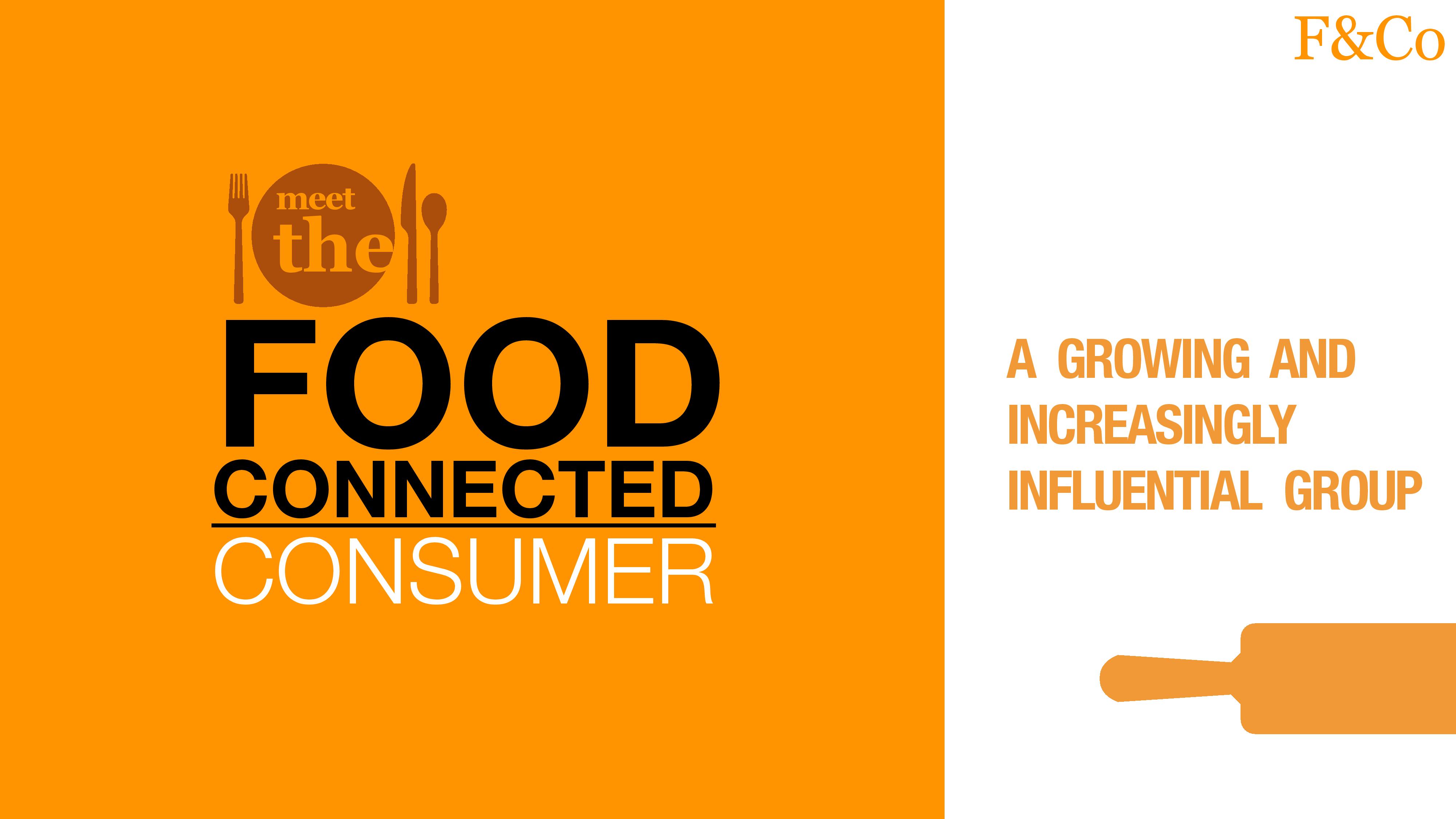
The study reveals a number of compelling data points of importance to marketers:
“These confident cooks may be swapping certain ingredients based on health concerns, flavor preferences, or even product availability. Brands can improve their chances of being the consumer choice through education, and demonstrating the product’s range of use,” said Fogelson. “And marketers shouldn’t be afraid to present new products and flavors – 67 percent of FCC consider themselves food explorers, which is fueling the global flavors trend.”
While the vast majority (91 percent) of FCCs look online for recipes and inspiration, they still shop at supermarkets, club and specialty shops, and farmers’ markets. And they regularly watch food shows (56 percent), read food magazines (30 percent) and follow bloggers or food experts online (20 percent).
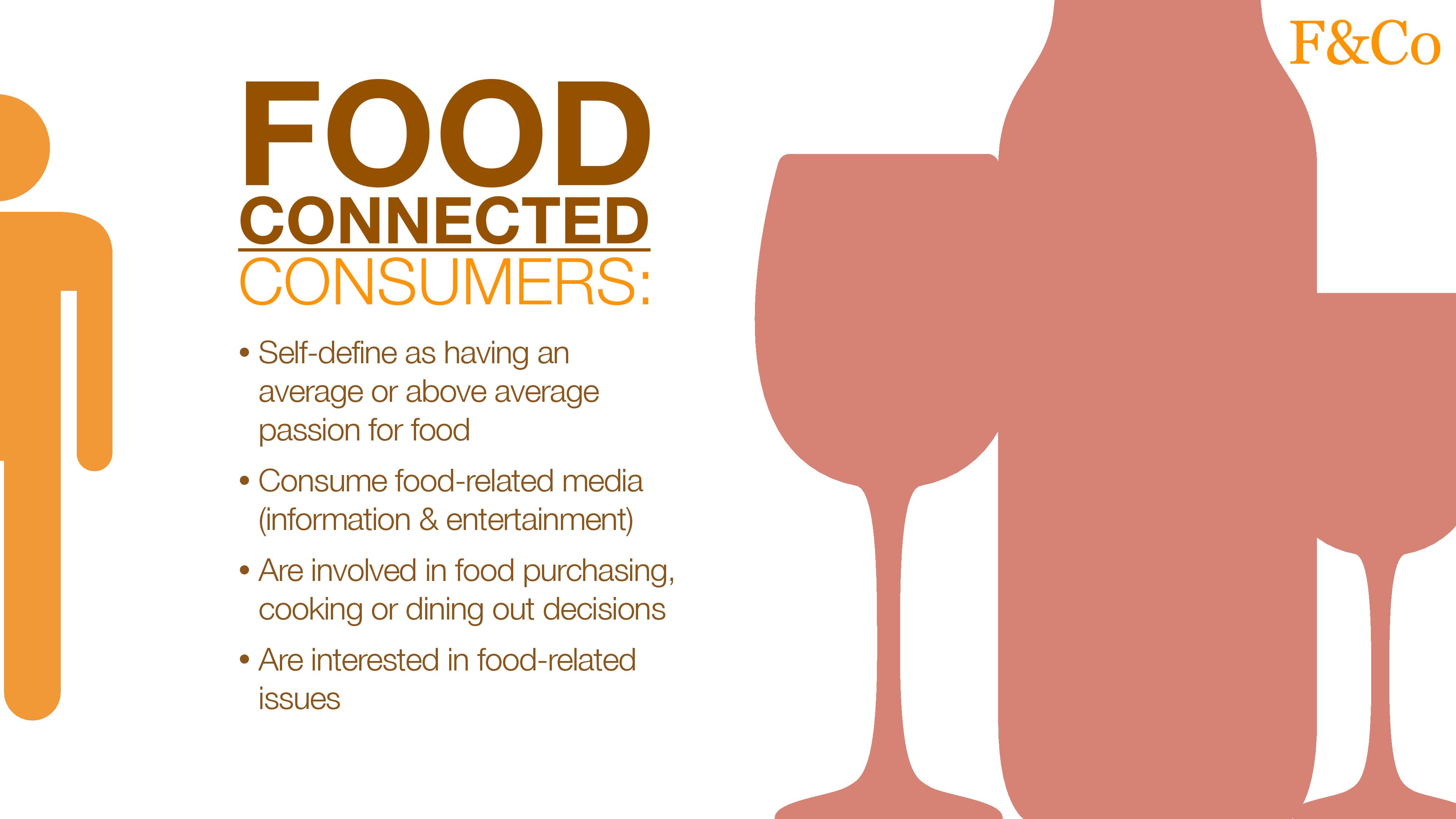
According to Fogelson, digital platforms are critical for food brands, but crafting stories that play across channels is the best way to capture their attention – and that includes engaging them at retail. “Digital is a clear priority, it’s where they’re finding inspiration and information, but developing the right mix across channels—and playing to each channel’s strength—is ideal.”
The majority of FCCs (72 percent) support causes they believe in and 50 percent say they try to buy brands that align with their values. They are also 26 percent more likely than the general population to look for foods with simple, recognizable ingredients.
The Power of Gen Z
In a follow up study, Generation Z’s passion for food is also evident, though in some different ways. Fogelson states, “Gen Z is really having a lot of fun with food. It’s a relief and a release from the perceived instability and uncertainty of their world.”
Over a third (37 percent) saying that snacking is their favorite meal and nearly half (47 percent) say they often eat breakfast foods at non-breakfast times. They also say they like to cook together with their family (40 percent) and, importantly, over half (54 percent) say they influence food purchases at home.
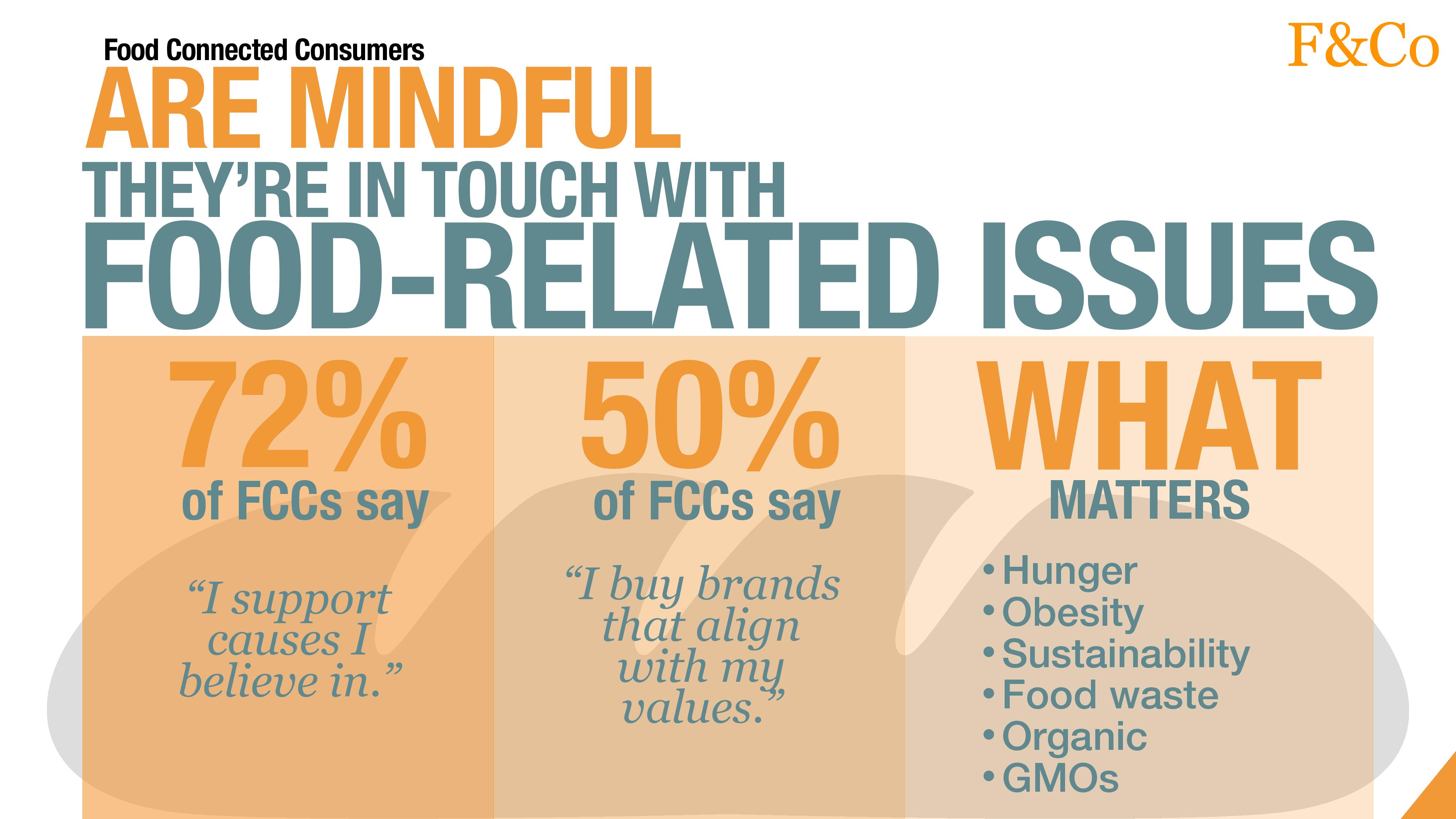
Fogelson notes that experimenting in these spaces could yield an excellent payoff for brands. “Quick service restaurants that are serving breakfast all day are certainly on target. And considering Gen Z’s influence on food purchases, brands must find ways to appeal to them to capitalize on their indirect purchase power.”
It’s Still All About Storytelling
FCCs, from Gen Z to Boomers, all care about where their food is from and its impact—on individual health and our world—just to varying degrees. “Tell your food’s story,” said Fogelson. “What is its origin? How was it made? Why is it the better choice—not just for consumers, but the world we live in? If the story seems elusive, embrace the truth of your product and tell that. Every brand – even many non-food brands – can have a food story that resonates with this powerful audience.”
For more findings and insights, click here.
The F&Co/Jump Rope Innovation study evaluated attitudes and behaviors around cooking, shopping, eating, media consumption, social issues and more. It was conducted online among 1,123 consumers age 18-54 in August, 2018. A follow-up study was conducted October 23, 2018 among 283 consumers age 15-22.
*Based on Bureau of Labor Statistics food expenditures data and FCC survey data estimates of income and food-related behaviors.
F&Co Study: The Rise of the Food Connected Consumer posted first on happyhourspecialsyum.blogspot.com
Modernizing Your Restaurant POS System: Four Best Practices
If you’ve been in the restaurant business while, you may think you’re too accustomed to your legacy POS system to make the switch to a new one. You’ve seen your colleagues and competitors upgrade their systems and you’re coming to terms with the truth: a modern POS system can lead to new business, less hassle, and greater efficiency for your restaurant. And while the transition may seem daunting, the benefits are likely too good to pass up, especially in such a competitive market.
Through the process, keep in mind these keys to making your POS transition as painless as possible:
- Ask associates about their experiences
- Let your staff in on the process
- Determine your priorities and make a choice
- Implement strategically
By incorporating these best practices into your plan, you can ease your transition to a modern POS platform and take your restaurant into the 21st century.

Luckily, there are plenty of restaurants and other businesses that have paved the way for you. If you’ve been in the industry a while, you likely know other restaurateurs and small business owners who have made the transition to a modern POS system. Ask them about their experiences to get a picture of the challenges you will face throughout the process.
Some of the most helpful questions you can ask:
What brand of POS did you choose, and are you satisfied with your choice?
What unexpected challenges did you face in the transition?
How long did you plan for the transition to take, and did you meet that goal?
How difficult was the actual installation of the new system?
What complaints have your employees had about the new system and/or the transition process?
What do you wish you had done differently?
How does your system handle payment processing? (For an introduction to this subject, see Double The Donation’s guide to payment processing.)
Online reviews are helpful as well, but it is definitely worth taking the time to talk to someone you know so you can ask any specific questions that the internet may not address.
Remember that you are not necessarily trying to find the best POS system—just the one that will work best for your restaurant.

Only you can decide what system to implement, but it’s also important that you ask your staff their thoughts.
They use the restaurant POS system as much or more than you, so it only makes sense to take into account their needs as well as yours when making your decision.
This process can also serve as a sort of “pre-training” by introducing your staff to some of the important concepts and possible changes they will encounter. If you are considering a major switch, like one from a legacy to a mobile POS (more on mPOS later), ask them if they have any anxieties or concerns regarding the change.
Then, keep them involved as you weigh the options and begin installing your new system. Continue to brief them on your decisions and ask them for feedback so they never feel left out of the process. The more engaged your employees are throughout the installation of your new POS system, the more comfortable they will be with it when it goes live.

Now that you’ve learned what to watch out for, collected the names of a few brands, and heard from your employees, it’s time to determine what features your restaurant needs and, ultimately, what POS system you want to go with.
One of the first questions you should ask about your next restaurant POS is whether or not you want a mobile system. Mobile point-of-sale (or mPOS) systems offer a range of features that can revitalize your restaurant’s preparation and service processes. Consider this option if you are ready for a significant change in the way your restaurant operates.
mPOS systems enable your servers to take and send orders, charge customers, handle electronic signatures, and show suggested tip options, all right from the table. These types of features generate extra efficiency which can lead to improved table turn and better revenue.
But many restaurants prefer not to implement such a significant change, and will choose to stick with a stationary POS option. For these businesses, a more modern system can still offer a slew of time-saving features while taking up less space than legacy systems.
While the choice between a mobile and stationary system will be one of the most influential decisions you make, there are many others things to consider as well:
Does the system track and compile data to help you manage your business? Most modern POS systems offer much more sophisticated data tracking and business analytics features than legacy systems. Weigh these against your management practices to make a decision that works for you.
Does the interface design work with your methods/does it offer significant customization? Only you and your staff know what works best for your restaurant. You may want to customize your new interface so it resembles your current one to minimize the need for training, or you may want to overhaul your interface to improve efficiency.
Is it secure? Unlike the above decisions, this should be influenced less by personal preference than by industry standards. A digital POS has to be secure, so make sure that your new system is PCI compliant and meets other cybersecurity guidelines so you never experience a hack or other emergency.
Does it work well with online ordering? If your restaurant receives a lot of business through online orders, you’ll want to make sure your new system supports that. Some systems can send orders straight to the kitchen from the web, saving a step for your restaurant’s host or cashier. This is an especially useful POS feature for business such as pizza parlors.
If you don’t already have several specific requirements in mind for your new POS, these questions will help get you started with the research process. As you learn more about the options, you’ll develop an understanding of your needs so you can choose the right system for your restaurant— and then start the transition.

Now it’s time to actually get rolling with the new system. Follow these steps to make the installation as smooth as possible so you can get back to work:
Data backup
Your data is important to your business, so you shouldn’t be forced to lose it when you make the switch to a new POS.
Your legacy POS system likely has an internal hard drive full of various data it has collected through the years. If you aren’t willing to start fresh with your new system, or just want to hold on to the data from the last few months, you’ll have to back it up.
If your system runs on Unix or Windows, it will probably be a fairly straightforward process. Check your system’s file menu for an option that says “backup/restore” and follow the prompts. Your new POS provider should offer implementation services to ensure that you get every piece of the transition process right.
You should also check the brand’s website for a more detailed guide on how to backup the database. Consult this information for hardware and software tips that will help you save all your data. As long as you have a cloud solution or hard drive that can connect to your new system, it shouldn’t be a problem to import the data and get it up and running.
Installation
Because the transition will inevitably require some disruption of normal business, try to schedule the most disruptive tasks during times when your staff won’t be too busy. Whether that means waiting until a slow season or a slow day, being strategic in this part of the process can save a lot of trouble.
Any period in which the POS system will have to be down momentarily should happen during a time with as little traffic as possible. This includes the first time you boot up the new system, as it will likely have to be configured before it’s ready to go.
Most managers say one of the most important selling points of a new POS platform is a simple simple installation process to minimize downtime. Check product reviews to find out about other customers’ experiences. Even if you can schedule your installation for after hours, you don’t want to waste your valuable free time setting up your POS.
Training
Now’s the time to give your staff a formal, comprehensive introduction to the new system. This time, the goal is to get them as close to work-ready as possible. Developing a working knowledge of the system yourself is the first and most important step in this process.
Consider choosing a brand that provides users with videos and guides for learning their POS system. Go through the guides yourself and then pass them on to your employees so you can go through them together. Getting everyone on the same page is the last step to implementing your new system.
Making the change to a modern restaurant POS system will likely require some adjustments by your restaurant—don’t make it harder than it has to be. Taking the above factors into account will make for a quick and simple transition.
Modernizing Your Restaurant POS System: Four Best Practices posted first on happyhourspecialsyum.blogspot.com
Sunday 28 October 2018
MRM Share: Robots Take Over, Phygital and The Dronut
While Modern Restaurant Management (MRM) magazine provides a host of content on topics and issues important to restaurant industry professionals on a daily basis, we also share interestng restaurant- and food-related content on our social media platforms.
Here's a sample of what we shared this week. Be sure to follow us for more.
Sign of the Times
Starbucks opened its first U.S. Signing Store in Washington, D.C.
Unfortunate Sign of the Times
A restaurant closes due to lack of employees.
Robot Chefs and Waiters
What is being called the "world's first eatery with a fully automated kitchen" opened this week.
Virtual Restaurants
Why you need to know the word "phygital."
Dronuts
How could we not share a clip where a noted chef said: "There’s this Biggie/Tupac thing happening in food always."
Trend or Foe
Restaurants are requesting guests be present lock their phones away.
Corporate Cafeterias
The San Francisco Planning Commission recommended against an outright ban on new corporate cafeterias that was aimed at promoting local small businesses.
Perfect for Halloween
Here are some scary restaurant horror stories. And booze pairing for your candy.
The Meaning of Hospitality
How could we not share this update of a guest post for our friends at Toast.
MRM Share: Robots Take Over, Phygital and The Dronut posted first on happyhourspecialsyum.blogspot.com
Friday 26 October 2018
Let’s Get Visual: Five Tips to Visually Market Your Restaurant
In today’s world, it’s all about the visuals.
In restaurants especially, visual marketing is crucial in growing and maintaining a customer base, and keeping them hungry for more. How can you make the most of your restaurant’s visual presence?
Create #Food
As of the time of this writing, there are well over 170 million posts on Instagram under #food, and over 75 million posts to #foodporn. And that number will only continue to grow. People are increasingly choosing restaurants to visit based on their social media presence, and just as many are taking pics of the food they order and posting it online. The way your food looks online is incredibly important.
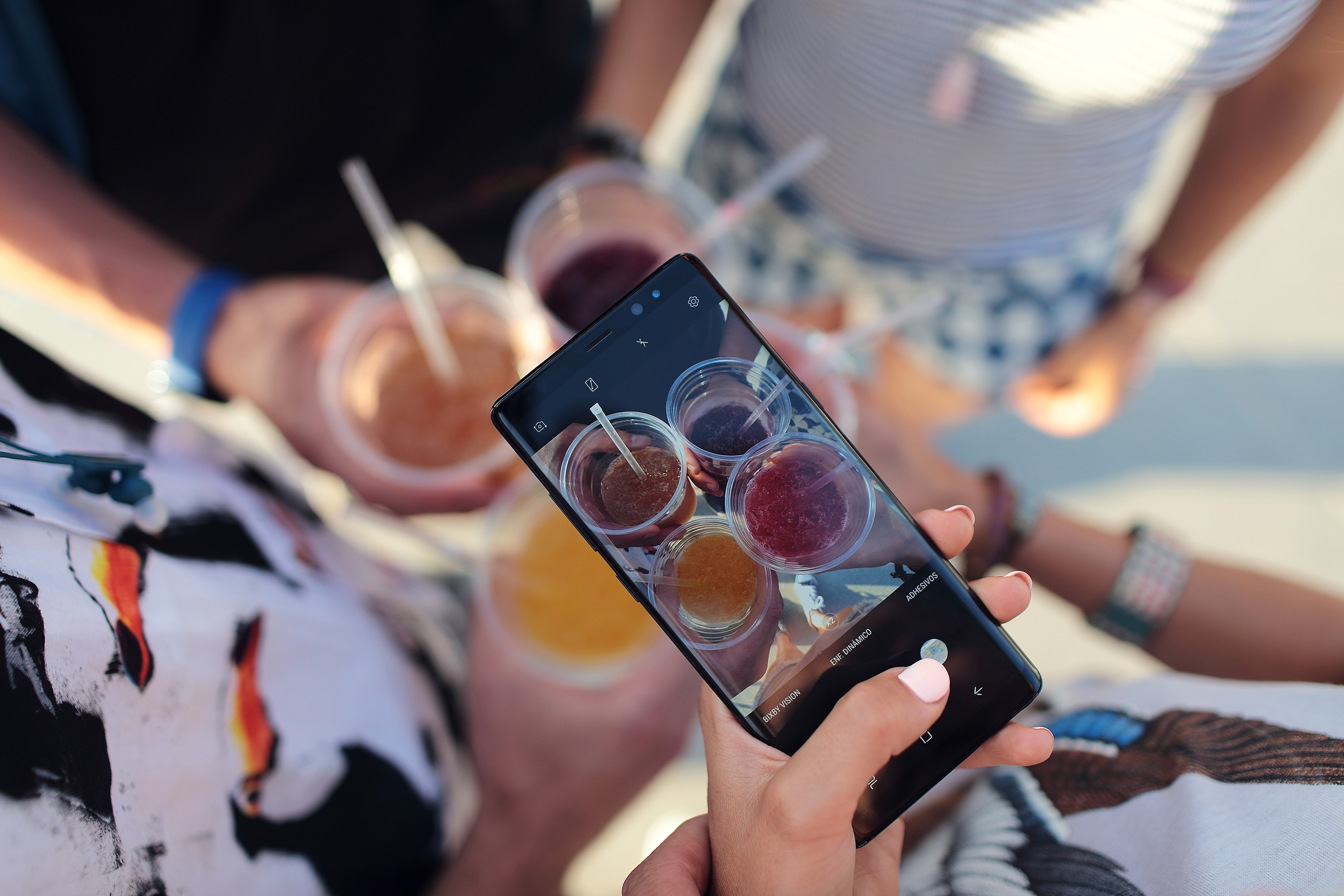
Choose a selection of your top dishes, and hire a professional food photographer to take the shots, and share them on your website and social media platforms. Sharing photos on social media can be a great way to advertise new dishes, drink or food specials, upcoming events and more.
Maximize Your Space
If your walls could talk, what would they say? The interior and exterior of your restaurant space is filled with opportunities for further cementing your brand and engaging customers. Get creative with your space: hire an artist to paint a visually stunning mural, hang chalkboards on the walls or use erasable decals to list daily specials or list your social media hashtags on the front of your menus. Try floor decals pointing customers towards the restrooms, artistic window signage that advertises happy hour specials or badges and customized t-shirts for staff to wear that support your brand.
Brand Your Vehicle
If you have a delivery vehicle, or even if it’s your own personal vehicle, don’t miss this opportunity to take your restaurant’s message on the road with you. Use bumper stickers or decals to advertise your restaurant’s name, number and website, or hire an artist to create an image that will make an impact on people on the street.
Give Them a Little Something
Offering customers mints with the bill is a standard nicety for restaurants, but offering specialized branded swag to customers is another way to make them feel valued and increase your brand presence.

Making stickers of your company logo available to customers can be an incredibly effective marketing tool – it doesn’t cost much, they will remember it as a unique gift, and will likely either share the stickers with friends, or slap them on a space where others will see, such as bumpers, walls, cellphones, laptops and bags. The Canadian store Smoke’s Poutinerie ran a guerrilla marketing campaign using stickers and social media to build a veritable poutine empire throughout the city for minimal cost.
Dress Up the To-Go Box
Many restaurants offer standard white styrofoam boxes and plastic or paper bags for delivery and to-go items. But these are a chance to surprise your customers with creatively-designed packaging that shows you pay attention to the details. Set yourself apart from the competition with branded boxes and bags that are visually pleasing, as well as useful. These are a great place to put your restaurant’s website, social media hashtags, or any other information you want your customers to take with them.
Let’s Get Visual: Five Tips to Visually Market Your Restaurant posted first on happyhourspecialsyum.blogspot.com
Thursday 25 October 2018
More Than Candy For Dinner: Halloween and Food Delivery (Infographic)
It turns out trick-or-treaters won’t be the only ones knocking on residents’ doors this Halloween – food delivery drivers will be showing up to deliver treats to folks who want more than candy for dinner. According to a recent online survey, 33 percent more people are planning to order food delivery for dinner on Halloween this year than last.
Thirty-three percent more people are planning to order food delivery for dinner on Halloween this year than last.
Convenience-seeking millennials have the largest appetite for getting dinner delivered on Halloween. The study shows one in ten people ages 18-34 plan to order delivery, that's two times more than those 35+. This echoes other recent reports that millennials are three times as likely to order in than their parents.
Speaking of parents, consumers with children in the home are 12 percent more likely to get delivery for the holiday than non-parents.
And just as kids collecting candy have their most-loved sweets, data shows food-delivery fans favor pizza, fries, Chinese food and sushi more on Halloween than the typical night. While apparently steak, pasta and curry don't pair as well with Reese's and Skittles, as all three tend to drop in popularity for the night. We compiled our findings in the infographic below.

More Than Candy For Dinner: Halloween and Food Delivery (Infographic) posted first on happyhourspecialsyum.blogspot.com
What’s Weighing You Down? (You’re Not Alone)
Customer Service: it’s the Achilles Heel of the business world. Important, but hard to get right with all its moving parts. In 2016, U.S. businesses lost $62 billion due to poor customer service, up $20 million from 2013, reports New Voice Media.
Still, customer service likely hasn’t declined that much in three years, right?
More likely customers are turning up the volume when talking about it—and posting about it in the form of reviews—and other people listen.
Word of mouth is coming home to roost big time. Nielsen says 92 percent of consumers rely on recommendations from friends more than advertising.
Let’s deconstruct the poor customer service experience in the restaurant industry. It looks something like this:
- Dirty kitchen/restaurant
- Employees who are rude, slow or inattentive
- Poorly executed food
- Food served past its hold time, so it’s old and possibly cold
- And, most concerning, food served past its expiration date, which can make someone sick.
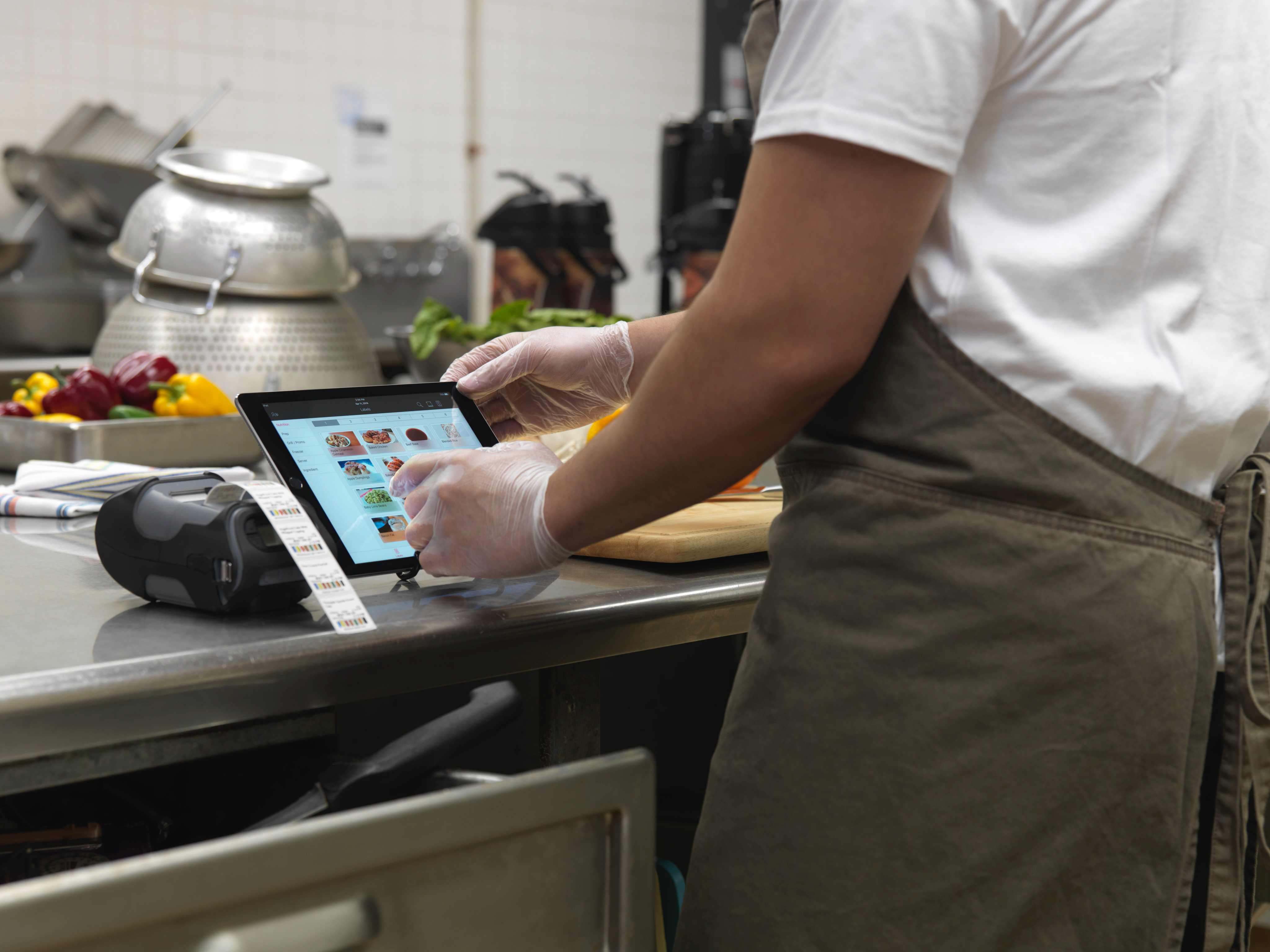
That all happens at the counter, but these mistakes originate earlier, likely before the doors are unlocked, when employees are tasked with cleaning, food rotation and prep, stocking stations, and properly labeling food.
Change Your Fate and Automate
Tablet Systems: Get them to track food rotation and training. Employees can also automate food prep labeling on the spot for greater accuracy and safety.
Task Trackers: Get rid of the paper checklists and go digital with applications that require employees to check off tasks as they’re finished, whether cleaning, food prep or getting coolers ready for the day. They also monitor food temperature to ensure food is safe to serve. All information is stored digitally and can be analyzed to ensure compliance.
Donate and Waste: The National Restaurant Association reports 30 to 40 percent of food is wasted. Tracking what’s not used will improve the inventory ordering process and decrease the chance something past its prime is served, not to mention the gift of goodwill through food donation
The technology is at our fingertips; it’s a shame not to utilize it. Automate the basics and watch your customer reviews improve and your word of mouth increase.
What’s Weighing You Down? (You’re Not Alone) posted first on happyhourspecialsyum.blogspot.com
A Cut Above
Albert Allaham opened Reserve Cut in Manhattan’s Financial District five years ago with a lofty goal: to redefine the kosher dining landscape and encourage non-kosher guests to explore and enjoy the cuisine.
The 200-seat dining room evokes a contemporary steakhouse atmosphere with black leather chairs, gray banquettes and imported silk tapestries. The restaurant also features an elaborate wine cellar complete and an extensive wine list, with nearly 100 different bottles from Israel, Australia and Italy. Allaham is a master butcher and owner of The Prime Cut in Brooklyn, which serves customers throughout New York.
In this MRM profile, Allaham and Executive Chef Michael Sullivan discuss how the restaurant operates under OU Glatt certification, the ambience and the unique menu.
A Cut Above posted first on happyhourspecialsyum.blogspot.com
Guerilla Marketing Tactics for Small (Or Not-So-Small) Restaurant Owners
No or very little marketing budget? No problem. It’s time be creative and start some guerilla marketing. Here are a few ideas that I came across while talking to small restaurant owners. Some reported great success with them!
1 – Support Your Community
Visit your local schools and contact the PTA, the different athletic associations or the local bands. Chances are they are struggling to raise money. Most restaurants typically offer to host a spirit night and give 20% to 30% back from the guests these groups brought. Be bold, make an offer they can’t refuse, and give 30% back on all checks that night. If your restaurant is seen as a pillar of the community, they will support your business in return.
2 – Explore Cross-Marketing
Is there a local performance theater or movie theater in your neighborhood? Contact them and see if they would work with you to offer a date night package, including show tickets and a romantic dinner for two at a discounted price. This could work especially well around Valentine’s Day.
3 – Offer Free Lunches to Surrounding Businesses
Visit small local businesses or contact the HR departments of larger businesses and offer to host free lunches for their employees. Make sure you print flyers and place signs to get your name out. Also, if you deliver, create a special lunch offer for those businesses to encourage them to visit your location.

4 – Gift Cards for New Homeowners
Contact local real estate agents or leasing offices and offer them gift cards for your restaurant to give to new homeowners or new tenants. Usually, they will have welcome packages and will appreciate having something of value to give to their customers.
5 – Provide Free Food at Open Houses
While you are talking to local real estate agents, offer to provide them with free food for their open houses. Make sure you keep the food provided simple and easy to eat, otherwise, you may have a very angry real estate agent to deal with (nobody wants spaghetti sauce on their carpet!).
6 – Happy Hour for Businesses or Communities
Reach out to local businesses or communities and offer to host a happy hour for their group. Make it enticing by providing the food for free or drinks at discounted prices. Keep those happy hours specific to a group to encourage them to come. If you make it generic, you may not get the expected results.
You see? No need for expensive ads or useless inserts in community newspapers. Be creative, be true to your brand, support your community and chances are, they will support you back.
Guerilla Marketing Tactics for Small (Or Not-So-Small) Restaurant Owners posted first on happyhourspecialsyum.blogspot.com
Wednesday 24 October 2018
Lamb in Japan, More Slices of Pizza Museum and 2018 Food Tourism Trends
This edition of MRM's News Bites features Superior Farms, DoorDash, Roosevelt Collection, Pupatella, B.GOOD, Ordrslip and Square, Inc., The American Food Association, The Gluten Intolerance Group, CheapOair.com and Wylie Dufresne and BlueStar® appliances.
Send news items to Barbara Castiglia at bcastiglia@modernrestaurantmanagement.com.
Lamb in Japan After 15 Years
Superior Farms, a purveyor of farm-to-table American lamb, today announced it has exported the first shipment of American lamb to Japan since the country’s doors reopened after a 15 year absence. Superior Farms is working closely with its producer partners to deliver an exceptional product that will exceed the expectations of the Japanese consumer. The Japanese distributor, Farmland Trading will be working with Superior Farms to introduce premium Superior Farms American lamb to high-end restaurants and retail outlets.
“We have continued our relationship with Farmland Trading for fifteen years anticipating this day,” said Rick Stott, chief executive officer at Superior Farms. “This shipment represents a first step in a long-term strategic plan to grow the presence and appetite for American lamb in Japan. The potential to develop Japan into an excellent export country for American lamb is clearly there, but it will take time, investment and a long-term strategy to make that happen.”
Superior Farms is working closely with their family farmer partners to raise grain-fed lambs that are raised and hand selected at just the right time to deliver a rich, mild flavor with the size and yield that only Superior Farms American Lamb can deliver. While the Japanese market has been served by other countries, Superior Farms American Lamb brings a unique dining experience to Japan both inside and outside the home, with recipe versatility and unparalleled taste and quality that cannot be matched.
The company’s 412 employee owners are excited about the opportunity for Japanese consumers to experience the pleasure of the product that they so proudly bring to market. “We’ve always known that Superior Farms brings something special to people’s lives,” said Shaylynn Beam, sales and marketing coordinator. “It’s great to think of others who haven’t experienced us and will now get to enjoy American lamb.”
DoorDash Launches in New Hampshire
DoorDash launched across three counties in the New Hampshire area, delivering from more than 500 local restaurants. DoorDash currently operates in more than 1,200 cities across the country. DoorDash will be available in the following 18 cities across Merrimack, Hillsborough, and Rockingham counties:
- Allenstown
- Atkinson
- Auburn
- Bedford
- Concord
- Derry
- Hampstead
- Hooksett
- Hudson
- Litchfield
- Londonderry
- Manchester
- Merrimack
- Nashua
- Pembroke
- Salem
- Suncook
- Windham
"We are thrilled to expand our platform to the state of New Hampshire with this launch into 18 new cities across the region," said Tony Xu, CEO and Co-founder of DoorDash. "With family favorite restaurants that locals gravitate towards, we're pleased to now offer our platform to these favorite neighborhood hot spots."
Pizza Museum Extends Stay
U.S. Pizza Museum is extending its stay, according to the Roosevelt Collection. Open on Fridays from 5-8 p.m. and Saturdays and Sundays from 11 a.m.-6 p.m., the museum features Founder Kendall Bruns’ personal collection of pizza-themed memorabilia – including menus, rare pizza boxes, vinyl records, vintage ads, toys, video games, and more. New additions to the museum include an authentic Forno Bravo wood-fired oven and a vintage coal bucket that accompanies the Coalfire Pizza sign.

“The U.S. Pizza Museum staying at Roosevelt Collection through the holiday season is great news for Chicagoans and visitors alike,” says Shannon Ridgeway, General Manager of Roosevelt Collection Shops. “We are thrilled to offer guests a fun and truly unique experience in a location where they can also shop, work out, and see a movie.”

Bruns’ museum preserves and interprets pizza-related items in both a present-day and historical context. Entry to the U.S. Pizza Museum is free with required online reservation for timed entry.
“Roosevelt Collection has been a wonderfully supportive partner to the U.S. Pizza Museum and as I’ve had time in the space and gotten to know the neighborhood, I continue to get new ideas for events, exhibits, and additions,” says Bruns. “As we make more tickets available, now even more people can come visit to learn about the history and recent developments in the world of pizza.”
Pupatella Fuels Expansion
Pupatella secured an investment of $3.75 million from several notable private investors to fuel expansion in the Washington, DC metro area. As many as eight company-owned pizzerias are planned over the next 36 months.
Husband and wife founders Enzo and Anastasiya Algarme started Pupatella as a food truck in 2007, then opened their first pizzeria to great accolades in Arlington in 2010. “In my home of Naples, classic Neapolitan pizza can be found on every corner. After not finding pizza like home, I became passionate about sharing the delicious food of my youth. We are thrilled to bring more Pupatella pizzerias to our Washington-area neighbors,” said Enzo Algarme.
Pupatella’s “back to the basics” approach to classic Neapolitan pizza was a resounding success and prompted a partnership with founding partners of Elevation Burger in 2016 to grow the brand through franchising and corporate development. Most recently, the company has brought in Adam Winder as a partner and chief financial officer. An experienced banker specializing in corporate strategy, Winder led the recent capital raise. “The Pupatella leadership team and its unique position in the marketplace as an authentic Neapolitan, neighborhood-centric, casual format pizzeria makes for an exciting niche and rapid growth opportunity,” said Winder.
Pupatella’s first franchisee, Zeeshan Kaba, opened a successful pizzeria in Richmond’s Fan District in 2017 and is debuting his second of four pizzerias in Glen Allen this fall. While Kaba continues the company’s success in Richmond, the Pupatella team is focused on corporate expansion in the DC Metro area. “With our established brand and the strength of our investment partners, we are positioned for successful and well-paced growth in the Washington metro area and beyond,” says Michael Berger, founding partner and head of real estate & supply chain.
Pupatella achieved certification by the Naples-based Associazione Verace Pizza Napoletana (VPN) and remains obsessed with maintaining the authenticity and quality of the pizza in all of its upcoming pizzerias. The pizza is made according to nearly 150-year-old Neapolitan techniques, and the dough is prepared with only four ingredients: 00 Italian flour, sea salt, fresh yeast, and water. Each pizza is baked in a traditional wood-fired oven made of brick from Mount Vesuvius and cooks in around 90 seconds. Ingredients are imported weekly from Naples.
B.GOOD in the Midwest
B.GOOD opened three new stores in the Chicago metropolitan area – marking its foray into not only Chicago, but also the Midwest. The farm-to-table restaurant will open its doors in Vernon Hills on October 25 followed by openings in Schaumburg and Naperville in mid-December.
Founded in 2003, the Boston-based company proudly serves “Food with Roots” – sustainably-grown, fresh and wholesome food prepared fresh in-house. With a diverse range of menu options, B.GOOD offers consumers ingredients sourced from local, independent farmers, customers can expect to see seasonal menu changes that align with the local harvests. Local sourcing partners for Chicago include Bobtail Ice Cream Company, Gotham Greens, Russell Costanza Farms, MightyVine, and Highland Baking Co.
“We have always wanted to be in Chicago, and in looking at our growth plans, the timing was right. We found the Chicago market has been underserved when it comes to locally grown, healthy fast-casual options, and I am excited to introduce B.GOOD and all we have to offer to help fill that void,” said Chris Fuqua, CEO of B.GOOD. “Whether customers want a seasonal salad, a burger and fries, a healthy spin on spaghetti and meatballs or a smoothie, we have options they can feel good about eating – and giving their kids. I am thrilled to expand to this new market and bring Chicagoans food made with great tasting, high-quality ingredients – and partner with local farmers to make that happen.”
B.GOOD currently has 70 locations across the globe, with more than 50 in the U.S. alone and additional openings slated in the greater Albany and Charlotte markets later this year. The three new Chicago stores are located at:
- Vernon Hills, IL: Mellody Farm, 875 North Milwaukee Avenue, Vernon Hills, IL 60061 (Opening October 25, 2018)
- Naperville, IL: Springbrook Prairie Pavilion, 2555 W. 75th Street, Naperville, IL 60540
- Schaumburg, IL: Woodfield Gatherings, 1721 East Golf Road, Schaumburg, IL 60173
Ordrslip Teams with Square
Ordrslip has teamed up with Square, Inc. to help bring independent restaurants, food trucks and eateries of all sizes into the mobile era. The first-of-its-kind partnership for Ordrslip will give Square customers instant access to Ordrslip in the Square App Marketplace on Nov. 1.
"Mobile ordering is the biggest trend affecting the food service industry, and smaller restaurants that don't have the expertise or resources to create their own mobile ordering apps risk falling behind," said Miguel Alarcon, product manager, Ordrslip. "Now that Square is supporting Ordrslip, we are thrilled that even more restaurants will have access to our technology and can compete on the same level as the largest chains when it comes to mobile ordering."
"When we opened our first location, we knew we wanted to offer a mobile app and Ordrslip allows us to do that in a cost-effective way," said Miguel Reyes, owner, Quesadilla Gorilla. "With Ordrslip, customers can create customized quesadillas, just like when they order at the restaurant. And, the app improves our to-go order accuracy, while also being faster and more efficient than having an employee stand by the phone during the lunch rush. Our mobile app by Ordrslip really sets us apart."
Mobile ordering is expected to become a $38 billion industry by 2020, making it essential that restaurants of all sizes launch their own apps to remain competitive. On average, Ordrslip users see well over a 90 percent increase in orders and bigger tickets for every order received after deployment.
"With Ordrslip's help, we launched our mobile ordering app at the end of 2017," said Desiree Mcfetridge, director of sales & marketing, Harris Ranch Inn & Restaurant. "It was a seamless, easy, and quick process collaborating with them."
Fraser Committee Chair for Global Cuisine Awards
The American Food Association, the hosting organization for the Global Cuisine Awards (GCA), announced their Committee Chairman for this year’s award show, Chef Neal Fraser. Chef Fraser began his professional culinary career at the age of 20 and now owns multiple renowned restaurants in Los Angeles with his business partner and wife Amy Knoll Fraser, including Redbird and Fritzi Coop. The 2nd Global Cuisine Awards will be held at Chef Fraser’s high-volume special events and performing arts venue Vibiana located in Downtown Los Angeles on Thursday, December 6.
Chairman Fraser has been working with the 12 GCA Committee members to narrow down the nominated restaurants list from 7 to 5 in each category.
The Top Five Nominees for each category are:
Best American Restaurant: Animal, A.O.C., Rustic Canyon, The Tasting Kitchen, and Otium;
Best Chinese Restaurant: Bistro Na's 那家小馆, Chengdu Taste 滋味成都, Din Tai Fung 鼎泰丰, HaiDiLao Hotpot 海底捞, Shancheng Lameizi 山城辣妹子;
Best French Restaurant: L'Assiette Steak Frites, Marvin, Mélisse, République, Trois Mec;
Best Italian Restaurant: Cal Mare, Osteria La Buca, Scopa Italian Roots, Sotto, Uovo;
Best Japanese Restaurant: Izakaya Gazen, Marugame Monzo, Matsuhisa, Sushi Ginza Onodera, Urasawa;
Best Korean Restaurant: Genwa Korean BBQ, Kang Ho-Dong Baekjeong, Master Ha, Soowon Galbi, Sulga Jinju Gom Tang House of Beef Soup;
Best Middle Eastern Restaurant: Bavel, Farsi Cafe, Kaban Persian Restaurant, Kismet, Oasis Mediterranean Cuisine;
Best Restaurant Design: Catch LA, Commissary at Line Hotel, Herringbone, Rocksugar, Rossoblu;
Best Seafood Restaurant: Bottlefish, Connie & Ted's, Fishing with Dynamite, Son of a Gun, Providence;
Best Southeast Asian Restaurant: Cassia, Little Sister, Nong La Café, Pa ord Noodle, Pho Saigon Pearl;
Best Steakhouse: Baltaire, BOA Steakhouse, Gwen, Mastro's Ocean Club, Nick + Stef's Steakhouse;
Chef of the Year: Antonia Lofaso, Curtis Stone, Josiah Citrin, Marcel Vigneron, Phillip Frankland Lee;
Lifetime Achievement Award: Gordon Ramsay, Nancy Silverton, Niki Nakayama, Nobu Matsuhisa, Wolfgang Puck;
Restaurant of the Moment: A Food Affair, Faith & Flower, Marugame Monzo, Rosaline, Vespertine;
Restaurant of the Year: Broken Spanish, Rustic Canyon, Jon & Vinny's, Perch, Running Goose;
Outstanding Culinary Tradition: Anarkali Indian Restaurant, Little Next Door, Meals by Genet, Musso & Frank, Tara's Himalayan Cuisine
Gluten Intolerance Products Certification
The Gluten Intolerance Group (GIG) certified 623 products from 30 brands in August and September—the most products certified in a two-month period this year. The products, certified through GIG’s Gluten-Free Certification Organization (GFCO) program, include cereals, spirits, cookies, cakes, soups, supplements and more. Brands seek GFCO certification for guidance and expertise in gluten-free production and because retailers and consumers want the assurance of the GFCO logo on their packaging. The following products were certified by GFCO in August and September:
- Bru Broth—4 products certified, including Chicken Bone Broth, Cayenne Zen and Chicken Bone Broth, Hug in a Mug
- CBC Baking Co—7 products certified, including Banana Bread and Pumpkin Bread
- Connections Gluten Free—Chocolate Chip Coffee Cake certified
- Ethical Wine and Spirits—9 products certified, including FAIR Quinoa Vodka 1L and FAIR Quinoa Vodka 35cl
- Heartland Foods—Gluten Free Cornflakes and Gluten Free Rice Poppers certified
- IB GLUTEN FREE—167 products certified, including Apple Pie and Challah Bread
- IOF Powder—Organic Inulin Powder certified
- IOF Syrup—IOF Syrup certified
- Jinca Foods—225 products certified, including Cereal Goji Berry Coco and Cereal Golden Berry Bananas
- Journeyman Distillery—Field Gin and Field Vodka certified
- Jus By Julie—3 products certified, including Pea Puffs BBQ Flavor and Pea Puffs Sweet and Salty
- Kip’s Nut Free Kitchen—Granola Bark Cinnamon Crunch and Granola Bark Cocoa Crunch certified
- Lemon Perfect—3 products certified, including Lemon Perfect Coconut Lime and Lemon Perfect Cucumber
- Lotus Foods —36 products certified, including Forbidden Rice and Organic Jade Pearl Rice
- Muffin Revolution—6 products certified, including Banana Bam Bam—Paleo/GF Banana Blueberry Muffins, and Cha Cha Cha—Paleo Friendly/GF Chocolate Cherry Muffins
- NatureWise—15 products certified, including Biotin Whole Food Complex and Vitamin B6 Whole Food Complex
- New Cascadia Traditional—20 products certified, including Cinnamon Raisin and Farmhouse Sandwich Bread
- NutHouse!—8 products certified, including Coconut Chili Macadamias and Indian Ajwain Cashews
- NutHouse! Granola Co.—4 products certified, including Granola, Fennel-Orange and Granola, Original Recipe
- Odd Bagel—6 products certified, including Odd Bagel Gluten Free Cinnamon-Raisin Bagels and Odd Bagel Gluten Free Onion Bagels
- Purely —4 products certified, including Purely Pecans “Gimme Some Sugar” Pecan Butter and Purely Pecans “Nuttin But Pecans” Pecan Butter
- Rumble—3 products certified, including Rumble Dutch Cocoa and Rumble Vanilla Maple
- Sheylus—5 products certified, including Extra Virgin Olive Oil and Olive Oil
- Smoky Mountain Naturals—DIM + BioPerine 200mg certified
- South Georgia Pecan—4 products certified, including Almonds – Raw and Cashews – Raw
- Southland’s Finest—3 products certified, including Pecans – Raw and Walnuts – Raw
- Starseed Bakery—52 products certified, including Hot Cross Buns and Irish Soda Bread
- Stateside Urbancraft Vodka—Stateside Urbancraft Vodka certified
- Thriv Drink Project—10 products certified, including Beet 1 Shot and Ginger 1 Shot
- Tucson Tamale— 18 products certified including Black Bean & Cheese Tamales and Red Chile Beef
Food Tourism Trends
More travelers are visiting destinations specifically to learn and explore new cultures through their stomachs. CheapOair.com compiled this list of some of this year's most popular culinary travel trends and destinations.
Eat Your Greens: The Most Vegan-Friendly Destinations
2018 has quickly become the year of the sustainability-conscious consumer, particularly in the food industry. According to Google, web searches for 'vegan' reached an all-time high in 2018 and United States ranks fourth among countries performing this search1. As the number of people identifying as vegans continues to rise, so does the number of vegan restaurants around the world. Los Angeles, California, Berlin, Germany, and Tel Aviv, Israel are some of the most vegan-friendly destinations that you can visit. Each of these cities is not only known for having unique culinary scenes, but also for offering a range of vegan substitutes for their respective traditional dishes. The future is sure becoming friendlier to vegan travelers.
Take It to The Streets: Destinations with A Booming Street Food Scene
Food trucks, sidewalk vendors, street carts, and hole-in-the walls are no longer a guilty pleasure. Destinations like Ho Chi Minh City, Vietnam, Mexico City, Mexico, and Portland, Oregon have set the bar and blurred the lines between gourmet and fast food. Portland has a booming street food scene with over 500 food trucks. Meanwhile, in Mexico City more than 75% of locals eat street food at least one per week. Ho Chi Minh City has food stands on nearly every corner, of every block, in every district and travelers are flocking there for the tasty Vietnamese cuisine. These destinations prove that you can look outside of the fancy restaurants for some haute cuisine.
But First…Coffee: Must-Visit Destinations for Coffee Lovers
Drinking coffee has become a staple in the daily routine of many cultures. For those that love their cup of joe, Seattle, Washington, Istanbul, Turkey, and Medellin, Colombia are just a few destinations you should add to your travel wish list. Seattle is the perfect destination for coffee lovers as it's home to Starbucks; one of world's largest and most recognizable coffee brands. The city's coffee culture doesn't stop there. There are also a number of small, independent roasters scattered across the city. Travelers should also venture to South America to check out what's brewing. Medellin is the perfect starting point to explore Colombia's famed Coffee Triangle. In Istanbul, having Turkish coffee is almost ceremonial in the unique way it is prepared and served. The one thing that unites these different destinations is not only their love of coffee, but the way coffee shapes their culture, community, and way of life.
Say Cheese: The Best Cheese Destinations
Cheese is one of the most versatile and varied foods there is. Cheese enthusiasts can rejoice in the various options, styles, and destinations they can visit to get that perfect bite. Normandy, France is amongst the most famous cheese destinations, especially if you are a fan of Camembert. La Mancha, Spain is the place to go if you prefer Manchego, El Greco, or Don Quixote. For those who can't get enough Parmigiano Reggiano, head to the Emilia Romagna region of Italy where Parmigiano originated. When it comes to cheese, you could travel the world and still be unsure of what the "king of all cheese" is, but with these destinations you'll be ready to do the research.
Let's Wine About It: Unconventional Wine Destinations
From Old World to New World, the following are some must visit destinations for all wine connoisseurs. Alentejo is one of the largest wine regions in Portugal where visitors can sample a wide variety of wines and local delicacies. Cape Town, South Africa is home to the only new grape variety created outside of Europe and features some iconic wineries with Cape Dutch architecture. For those looking for a glass of wine with a view, head to Santorini, Greece. Santorini not only has nine indigenous grape varieties, but also has a fascinating wine museum.
I Scream, You Scream, We all Scream for Ice Cream: The Top Destinations to Eat the Best Ice Cream
We can all agree that ice cream is one of the few desserts that is both timeless and suitable for all ages. It's hard to go wrong when it comes to ice cream, but when it's done right it truly is an icy treat! If you are searching for the perfect scoop, we've got the scoop on some destinations you may want to check out. Italy is an obvious choice, but did you know you can find some of the best gelato in Florence? New York City is also an ice cream hotspot with its many specialty ice cream parlors. For a unique twist on the classic cold treat, visit Tokyo, Japan to try mochi.
Cheers: Where to Find the Perfect Pint
Brewing has truly become an international affair, so we've put together a list of a few destinations where you can find that perfect pint. Beijing, China has recently developed as an emerging scene in craft brewing as this ancient city continues to prove it can create modern marvels. St. Louis, Missourimay be home to brewing giant Anheuser-Busch, but it is also becoming a destination for craft brewing. Want to truly change it up? Forget Oktoberfest and head down to Rio De Janeiro, Brazil for their annual Craft Beer Festival.
Wylie Dufresne's Dream Kitchen
Wylie Dufresne, James Beard award-winning, Michelin-starred chef, advocate of the scientific cooking style known as molecular gastronomy, and more recently, chef and owner of Du’s Donuts in Brooklyn, has added a new title to his repertoire—BlueStar® All-Star. Chef Dufresne joins an exclusive group of chefs– including Michael Symon, Alex Raij, Mark Vetri, and Jonathan Benno– who are passionate about achieving restaurant quality results at home with high-performance, customizable BlueStar® appliances, handcrafted in Pennsylvania since 1880.
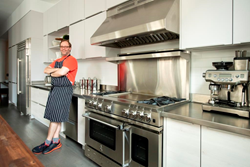
After recently acquiring his childhood home in Manhattan, the time came for Dufresne to renovate. Since the space held so many memories, the renovation was a true labor of love. He and his wife, Food Network Magazine Editor in Chief Maile Carpenter, knew precisely what they wanted and completely redid the layout of the space to fit their needs, opting for a sleek and open-floor plan that included the kitchen, family room and dining room – perfect for entertaining.
For the award-winning chef, it was all about bringing the most practical elements of a professional kitchen into his home. The kitchen renovation includes stainless steel countertops and a large walnut island for entertaining and food prep. The chef chose restaurant-style appliances from BlueStar® in stainless steel (range and ventilation hood) for a gorgeous, high-functioning kitchen.
“Commercial Grade is my favorite term,” said Chef Wylie. “I like things that are thoughtfully built and can handle a lot of action. We put our kitchen through its paces and wanted equipment that could come along for the ride with us. We’ve made good choices.”
The powerful BlueStar® 48” Nova Series gas range and 48” Incline hood were the clear choices for Chef Dufresne's new kitchen. “There’s a lot of BTUS in that stove so water boils incredibly fast; the BTUs are unstoppable,” said Chef Dufrense. The highly customizable BlueStar® Nova Series range features 22,000 BTU Nova™ Burners and an integrated 24” griddle. While the burners are perfect for a high heat sear, the commercial style griddle gets the most use in the Dufrense household. “I treat the griddle like a French Top; I can use it more efficiently than if I had 6 or 8 burners. I can put all the pancakes for breakfast on there or grill a lot of fruits and vegetables at one time – it’s great to lay out things in large numbers,” said Chef Dufrense. He also uses a combination of powerful burners to fry and the extra-large ovens to finish his signature French toast.
Ventilation was another important part of the remodel; since they could not vent externally, a recirculating hood was chosen. The recirculating option allowed Chef Dufrense to have pro-style ventilation within building specifications. It was a perfect solution since the right hood is crucial when you have a range with so much power.
Widely known for his ingenious creations at both his New York City restaurants wd~50 and Alder, Chef Dufresne turned his focus to donuts, opening Du’s Donuts and Coffee in 2017. Today, Du’s Donuts serves up Chef Dufresne’s recipes for New England-style cake donuts and crullers in classic and imaginative flavors including brown butter key lime, chocolate caramel brownie, coconut almond, and oatmeal chai. Chef Dufresne is branching out once again, selling his made-from-scratch treats in Whole Foods Market stores in New York City as well as coffee shops around Manhattan and Brooklyn.
Lamb in Japan, More Slices of Pizza Museum and 2018 Food Tourism Trends posted first on happyhourspecialsyum.blogspot.com
How to Win Every Customer’s Heart
Every service industry wrestles with one problem that is central to everything else we do. We pay a lot of advertising money to draw people ...

-
Every service industry wrestles with one problem that is central to everything else we do. We pay a lot of advertising money to draw people ...
-
This edition of Modern Restaurant Management (MRM) magazine's Research Roundup features F&B companies views on mobile technology, ...
-
McDonald’s recent acquisition of decisioning engine Dynamic Yield for $300 million is a clear indication of the vital importance of personal...